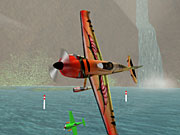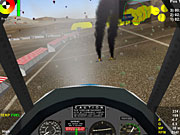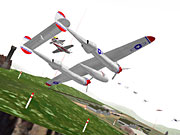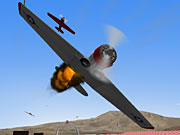An innovative departure from the conventional PC flying norms, Xtreme Air Racing fluttered onto the scene in mid-2002 to prove that a viable alternative to the studious flight simulation and the hell-bent air combat game did indeed exist. Essentially an airborne NASCAR, the game invited pilots to race unfettered through the skies, enjoying a semicomplex flight model and control scheme while also benefiting from a sense of competition not found in most civilian flight sims. Yet as novel and immediately engaging as it was, Xtreme Air Racing simply did not offer the same level of sophistication and visual quality found in the genre's top guns. Surely any sequel would need a substantial upgrade if it were to succeed in a market sprinkled with such awesome achievements as Flight Simulator 2004 and IL-2 Sturmovik. Sadly, such is not the case. Though developer Victory Simulations has kick-started things somewhat by adding a flock of new planes and courses--and a none-too-challenging combat mode--Redline: Xtreme Racing 2 otherwise looks the same, feels the same, and sports the same annoying quirks as its precursor.

A low-cost budget title, the original Xtreme simulated the world-famous air races held annually above Reno, Nevada. It allowed pilots to command digitized depictions of celebrated Reno air racing machines, such as Lyle Shelton's "Rare Bear" F8F Bearcat or Bill Destefani's "Strega" P-51 Mustang. The game didn't ask you to merely fly its aircraft, it mandated that you battle wingtip-to-wingtip, alongside other combatants, at speeds of over 500mph. Adding to the merriment was the close proximity of the cold, hard ground--at times less than a few measly meters away. The courses--with Reno's legendary Stead Field circuit serving as the centerpiece--were lengthy, pylon-ringed affairs that needed to be navigated several times before the checkered flag would fly. Supplementing the real-world Reno circuit were four fictional far-flung venues (UK, Arctic, Alps, and Thailand), each featuring distinct altitude variations that demanded careful engine selection and management strategy.
The racing was moderately challenging and the controls easy to master. Ultimately, Xtreme Air Racing was a wonderful excuse to break out the flightstick and blast through the virtual skies with a gaggle of 4000-horsepower WWII-era "unlimited-class" airplanes chomping at your tail. Who cared that the game's OpenGL-Glide graphics were well past their due date and, as a consequence, conveyed 500mph like it was 50. The racing was close and, at least, temporarily addictive, and that was all that mattered.
For its latest effort, Victory Simulations has incorporated several new perks, but, unfortunately, it left the core unchanged. Incredibly, the game is still powered by the same antiquated OpenGL-Glide graphics engine that prevented the original from registering any sort of visual impact with flight sim fans. What's more, Redline also signals the return of one Gordon Bowman-Jones, the irritating trackside race announcer who delivers his lines with such a grating lilt and sense of repetition that you'll, once again, be forced to rush to the audio setup screen to turn him off. Curiously, whereas Bowman-Jones has once again made the grade, Bob Hoover and his superb "Hoover's Hints" instructional segments did not. 'Tis a shame.
Certainly, Victory has added an impressive range of new elements. It has increased the number of aircraft to 70-plus, and the number of racing classes has increased from one to four. Two new venues, each of which incorporates a variety of circuit configurations, bring the total course count to 50-plus. And the available AI allotment in any one race has doubled from eight to 16. These are welcome--and certainly not insignificant--perks. However, the truth is that many of the aircraft deliver a similar experience, many of the courses look and feel virtually indistinguishable, and much of the racing that seemed so fresh the last time around now simply feels rehashed.
Whether the game is worth your hard-earned dollars depends on how much stock you place on aircraft and course variety in a game that's already far behind the current graphic and physics standards. Though there is considerable gameplay depth to be had here, there is not necessarily enough to justify the $30 upgrade from Xtreme.

PC pilots who haven't experienced the original game or are more accustomed to arcade-type action affairs will likely appreciate the responsive flight controls and uncomplicated racing premise of Redline. A joystick isn't mandatory, but it'll certainly make the experience much easier for newbies and veterans alike. After selecting your aircraft and racecourse (planes still need to be unlocked as you go, but the process is painless), the game moves you to a secondary screen where you'll jump into a practice session, qualifying heat, or straight into a race. Along the way, you'll encounter an aircraft setup submenu where you can choose different engine types to match the altitude of the course, and you can adjust your wingspan, prop diameter, airframe options, and fluid capacities. The latter refers to the amount of fuel you wish to carry onboard as well as the spraybar water level for engine cooling, ADI water/alcohol mix to offset engine knocking, and the number of power-boosting nitrous oxide bottles you estimate you'll need to make it to the end.
Once your aircraft is configured and the two-lap qualifying stint complete, you'll begin each race already airborne. From here, it's a simple matter of cracking your throttle wide open, navigating the individual pylons that line each five- to 24-mile course, and keeping a very watchful eye on your engine's temperature and "health" gauges. The wingtip-to-wingtip interaction with the other planes is surprisingly straightforward--after you've had a few laps under your belt--and midair and/or ground collisions are quite rare. In fact, the only seriously daunting challenge is dealing with the heavy "wake turbulence" you'll encounter whenever you follow another aircraft too closely. This buffeting effect, authentically re-created from real world situations, pitches your plane to one side and forces you to wrestle the stick and rudder to regain control, thus adding a very nice touch to the game.

Wake turbulence physics aside, Redline: Xtreme Air Racing 2 isn't a particularly sophisticated flight simulator. The physics modeling of its assorted aircraft is considerably simpler than that of other simulations, and player input is largely restricted to heavy-handed yank-and-bank tactics with little concern for accelerated stalls, spins, or even prevailing wind conditions. That said, each of the game's aircraft classes does offer a unique experience. The premier unlimited class is represented by nitrous-burning, heavily modified WWII fighter aircraft that max out at over 500mph. The new Formula 1 planes are lightweight spec aircraft that generally top out at about 300mph, and the new AT-6 and sport biplane class planes peg their airspeed gauges at around 230mph.
The sport of air racing would seem to be ideally suited to PC gaming, but much is lost in translation when the graphics can't match the pace of the action. This was a concern with 2002's Xtreme but has become a significantly more thorny issue in a game that's had more than an extra year to develop. Redline's bland terrain modeling and simplified aircraft renderings are reminiscent of defunct flight sims from the mid-'90s (hardly surprising when you consider the game's Glide and OpenGL origins). The sensation of speed when flying at treetop height is so negligible that you'll constantly recheck your instruments just to ensure that you're not flying below your stall speed. Conversely, the crash, pyrotechnic, and smoke effects, evident when your plane does auger into the ground, look surprisingly good.
Victory Simulations decided to hedge its bets when producing the original Xtreme by adding a functional air combat mode that allowed you to blast away at a solo AI-controlled aircraft with wing-mounted .50 caliber machine guns. This feature has also found its way into Redline, and, in fact, has been expanded upon. Now, you can waste your competitors during a race, too. Unfortunately, with unlimited ammo and a declassified Naval Air Warfare Center targeting system called EOT--for "Eyes On Target"--at your disposal, your aerial opponents don't really stand a sporting chance. Although mildly diverting and definitely amusing, this combat feature is in no way the equal of the dogfighting you'll find in any of the real WWII combat sims on today's market.
One carryover that didn't fare as well is the game's eight-person LAN and Internet multiplayer component. The matchmaking utility featured in last year's version has been dropped altogether, thus leaving multiplayer fans with some rather unappealing connectivity options. A niche product like Redline isn't likely to set a lot of sales records, so locating an online opponent through peer-to-peer IP address swapping is a tenuous exercise at best.

And finally, we would be remiss if we didn't mention the game's colossal loading times. Unbelievably, when you're playing a given course for the first time in a given session, you must endure at least a full minute or more of inactivity while the game makes the transition from menu interface to gameplay screen. This delay is trimmed to a substantially more acceptable time frame if you're returning to a course you've already accessed during the same session, but that initial holdup is frightfully protracted and perhaps even longer than it was in the original product.
If you own a copy of last year's game, then you already possess the guts of this year's follow-up. True, Redline: Xtreme Air Racing 2 has a few extra locales tossed in and features scores of new planes to fly, but it also sports the same tired power plant and discouraging foibles that kept the original from scoring highly with the PC flying crowd. Should Victory Simulations ever get around to building Xtreme Air Racing 3, here's hoping the company can justify a complete engine overhaul and some new paint. Though the racing action remains infectious in the interim, the game as a whole is sorely in need of some shop time.